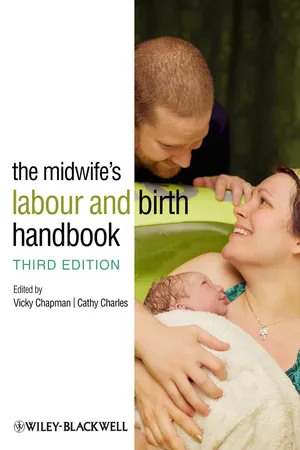
- English
- ePUB (mobile friendly)
- Available on iOS & Android
The Midwife's Labour and Birth Handbook
About this book
Praise for previous editions:
"An excellent resource for both student midwives and qualified staff alike." (Alison James, Midwifery Lecturer, Plymouth University)
"A lovely book with a lot of practical advice and easy to navigate. (Jayne Samples, Midwifery Lecturer, University of Huddersfield)
This fully revised and updated third edition of The Midwife's Labour and Birth Handbook is a practical and accessible guide to midwifery care.
It addresses important questions such as:
- Why are women being pressured into caesarean section for breech presentation when the evidence is equivocal?
- If a baby needs assisted ventilation breaths at birth, why not bring the ambubag to the baby and leave the cord intact so the baby can benefit from the extra maternal oxygen supply?
- Why is skin-to-skin contact at birth so rarely offered to preterm babies when there is evidence of benefit?
This well-regarded text promotes normality and woman-centred care, using research, evidence-based guidelines and anecdotal accounts from women. It challenges practice and guidelines which are biased or based on poor evidence. Guidance is offered on how to deal with difficult, sometimes controversial, situations.
The Midwife's Labour and Birth Handbook 3rd edition is an essential guide for both student midwives and experienced practising midwives.
New to this edition:
- Full colour photographs including a kneeling breech birth
- Suturing diagrams to assist left-handed midwives.
- Expanded chapters on slow progress in labour and malposition/malpresentations, including a rare photograph of a face presentation birth.
Frequently asked questions
- Essential is ideal for learners and professionals who enjoy exploring a wide range of subjects. Access the Essential Library with 800,000+ trusted titles and best-sellers across business, personal growth, and the humanities. Includes unlimited reading time and Standard Read Aloud voice.
- Complete: Perfect for advanced learners and researchers needing full, unrestricted access. Unlock 1.4M+ books across hundreds of subjects, including academic and specialized titles. The Complete Plan also includes advanced features like Premium Read Aloud and Research Assistant.
Please note we cannot support devices running on iOS 13 and Android 7 or earlier. Learn more about using the app.
Information
- Women should have as normal a labour and birth as possible, and medical intervention should be used only when beneficial to mother and/or baby (DoH, 2004, 2007).
- Midwife-led care gives the best outcomes worldwide: more spontaneous births, fewer episiotomies, less use of analgesia, better breastfeeding rates. Women use less analgesia, and report that they feel more in control of their labour (Hatem et al., 2008).
- Women should be offered the choice of birth either at home, in a midwife-led unit or in an obstetric unit (NICE, 2007), although only 83% report being offered any sort of choice (CQC, 2010). While an obstetric unit may be advised for women with certain problems, up to two thirds of women are suitable for midwife-led units or home birth (DoH, 2007), and the woman has a right to choose where she gives birth.
- Women should be offered one-to-one care in labour (NICE, 2007). The presence of a caring and supportive caregiver has been proved to shorten labour, reduce intervention and improve maternal and neonatal outcomes (Green et al., 2000; Hodnett et al., 2011).
- Increasing numbers of women rate midwifery support as positive (CQC, 2010), although a few midwives are regarded as ‘off-hand’, ‘bossy’ or ‘unhelpful’ (Redshaw et al., 2007).
- 5–6% of mothers develop birth-related post-traumatic stress disorder (Kitzinger and Kitzinger, 2007).
- Over two-thirds of Heads of Midwifery report they have insufficient midwife numbers to cope with their unit workload (RCM, 2009) which impacts on the quality of midwifery care women receive, reducing the chance of one-to-one care.
- The attitude of the caregiver seems to be the most powerful influence on women’s satisfaction in labour (NICE, 2007).
- 89% of fathers attend the birth (Redshaw and Heikkila, 2010) but there are other relationships e.g. lesbian couples, who have been less closely studied.
- The normal birth rate for England was 63% in 2010/11; in 2009/10 it was 60% in Scotland, 61% in Wales and 56% in Northern Ireland (BirthChoice UK; ESRI, 2011; ONS, 2012)
- The instrumental delivery rate was 12.5% for NHS hospitals in 2010/11; 16.7% in Northern Ireland (ESRI, 2011; ONS, 2012)
- The episiotomy rate for England is 8.3% for a normal birth; almost 20% overall (BirthChoice UK; ONS, 2012).
- The caesarean section (CS) rate for England in 2010/11 is around 25% (ONS, 2012).
Table of contents
- Cover Page
- Title Page
- Copyright
- Preface
- Contributors
- Chapter 1: Labour and normal birth
- Chapter 2: Vaginal examinations and artificial rupture of the membranes
- Chapter 3: Fetal heart rate monitoring in labour
- Chapter 4: Perineal trauma and suturing
- Chapter 5: Examination of the newborn baby at birth
- Chapter 6: Home birth
- Chapter 7: Water for labour and birth
- Chapter 8: Malpositions and malpresentations in labour
- Chapter 9: Slow progress in labour
- Chapter 10: Assisted birth: ventouse and forceps
- Chapter 11: Caesarean section
- Chapter 12: Vaginal birth after caesarean section
- Chapter 13: Preterm birth
- Chapter 14: Breech birth
- Chapter 15: Twins and higher-order births
- Chapter 16: Haemorrhage
- Chapter 17: Emergencies in labour and birth
- Chapter 18: Neonatal and maternal resuscitation
- Chapter 19: Induction of labour
- Chapter 20: Pre-eclampsia
- Chapter 21: Stillbirth and neonatal death
- Chapter 22: Risk management, litigation and complaints
- Chapter 23: Intrapartum blood tests
- Chapter 24: Medicines and the midwife
- Index